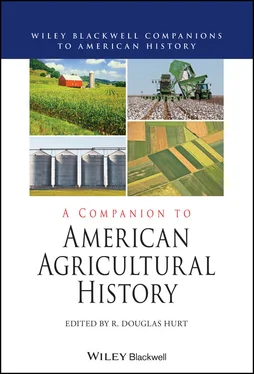By 1830, Ohio, Kentucky, and Tennessee had passed out of the frontier stage but the other areas had not. The land remained immensely forested, most agriculture was subsistence, farmers spent time hunting, and women engaged in cooking, clothes-making, child-raising, and home manufacturing. Most market activity was local and extensive trade only occurred if the farmer resided near the Ohio–Mississippi River system. The nature of the pioneer experience was arduous, isolated, and monotonous (Cashin 1991; Rohrbough 2008).
The most impressive feature of American agriculture 1790–1830 was the cotton boom. The British invented textile manufacturing machinery for which cotton was the best fiber, and then British and finally world demand for cotton soared (Beckert 2015). The United States became by 1820 the prime supplier of the fiber to England and then the world. Eli Whitney’s cotton gin in 1793 enabled widespread cultivation of the plant by mechanically removing the seeds from the boll of green seed cotton, the plant variety that grew exuberantly in mainland southern soil. Cotton raised in the United States in 1790 was merely 3,000 bales; by 1830, it was 732,000 bales (a bale weighed 400 pounds; US Bureau of the Census 1975). Because of world demand, cotton became by far the most valuable American export.
Of all American agriculture in this period, cotton cultivation showed the most impressive dynamism in experimentation and change. This experimentation involved the search for a seed that would allow quicker harvesting. The early seed was a variety such that a field hand might be able to pick 50–60 pounds per day. Planters experimented by cross-breeding with Mexican cotton seeds and produced the Rodney seed; with the Rodney seed, field hands might collect 200–300 pounds of cotton per day (Moore 1988).
This productivity advance was matched by alterations in plantation management—an ignominious story. Planters needed great numbers of laborers; this meant slaves of African descent, which they obtained from the domestic slave trade, from migrating planters, and from those escaping the Saint-Domingue Revolution of the 1790s (Berlin 1998; Deyle 2005). Cotton planters managed these slaves by the “gang” system using white overseers. Compared to tobacco, cotton work routines in the Deep South were more strict and disciplined, and the use of the whip more frequent. By the 1830s, the use of slaves in a regimented manner to generate high output of cotton on the plantations was in place (Fogel and Engerman 1989; Berlin 1998). Planters also raised much corn for slaves and animals, and practiced a form of the long fallow to preserve soil fertility (Moore 1988; Majewski 2009).
Sugar and rice plantations were the other large-scale agricultural undertakings of the slave South. Knowledge of sugar cultivation and production came to Louisiana from French sources, especially after the Saint-Domingue Revolution. Sugar production required much capital and skilled labor. The basics of Louisiana sugar arrived after 1795, including a better cane (ribbon cane in 1817) and the Jean Etienne de Boré innovation of turning the cane juice into granulated sugar (Joe Taylor 1963; Rodrigue 2001). Rice planters experimented. They increased the crop yield, improved drainage and sluices, and used machines to separate the seed from the husk (Coclanis 1989; Chaplain 1993). Both sugar and rice production were known as miserable occupations for slaves because of heat, humidity, and tropical diseases. Rice cultivation, though using the task system, was probably the worst as the cultivators had to wade through mud and stagnant pools to make cultivation possible (Berlin 1998; Morgan 1998).
The border or upper slave states had a different trajectory than the states devoted to cotton. They had economies mutating away from plantation slavery (though plantations there certainly existed) and they were slowly adapting to mixed-crop agriculture. While the cotton boom states had slave populations that constituted nearly 45–50 percent of the total population, the Upper South states had slave populations of between 15 and 30 percent. The Upper South states had more of a yeoman farmer character than the plantation states, but they lacked the prosperity of the cotton belt. The most interesting states were Maryland and Virginia. The foreign market for tobacco had disappeared, and so planters turned to wheat. In western Maryland and the Shenandoah Valley, wheat became the new staple of prosperity. But in the Tidewater and parts of the Piedmont, the embrace of wheat brought disaster between 1790 and 1820 because the planters exhausted the soil (Walsh 1993; Berlin 1998).
A persistent puzzle about the antebellum South is the condition of the average, nonslaveholding white farmer. It is likely that a considerable yeoman farming culture existed in the years 1790 to 1830 in which farmers probably owned their own land and existed in kinship neighborhoods. Most yeomen lived on land of marginal fertility, the “pine barrens” and elevated areas where cotton and tobacco could not grow. These farmers probably had an adequate standard of living, but they were by no means prosperous (Bolton 2005; Hyde 2005).
Northern States, 1789–1815
The farmers in the New England states in this period were primarily known for emigration to the West. Those who remained in Massachusetts, Rhode Island, and Connecticut turned to livestock, fodder, truck farming (vegetables), and orchards as a means of livelihood; they could so because of urbanization. But the most important agricultural export of the New England area after 1790 was its farmers (Barron 1984; Alan Taylor 1990; Henretta 1991; Christopher Clark 2006).
Great change did not come to the middle coastal states of Pennsylvania, New York, and New Jersey between 1790 and 1830. They were the breadbasket of the colonies, where wheat continued to be the main crop. Farmers used the same technology that they had acquired before the Revolution and kept to the same crop rotations. By 1800 and afterward, due to soil exhaustion, farmers began to use clover and other root crops as a way to regenerate the soil. Change was distinctly connected to rise of the cities of the region: New York City, Philadelphia, Baltimore, and Albany. By 1815, urban areas induced farmers to engage in truck gardening and butter and cheese production (Bruegel 2002a; Stoll 2002). New York housed great landlords who rented their land, but the notable protests against them came after 1830. In Pennsylvania wheat was strong in the southeastern part of the state and farmers also raised much swine and livestock for the Philadelphia market. Overall, farmers in both New York and Pennsylvania sought competency and independence rather than commercial success (Fletcher 1950; Mancall 1991; Bruegel 2002 a).
Northern agricultural practices generally followed colonial precedent, but in 1815 all that was about to change.
The Transportation Revolution: Initial Stage, 1815–1830
Americans and Europeans heard and witnessed the boom of the rise of the cotton kingdom; many were staggered by the wealth cotton was bringing to the plantation lords. The boom that was neither heard nor remarked upon was the northern agricultural economic explosion. The northern boom was ignored, first, because it came to be overshadowed by the arrival of early industrialization along the east coast, and, second, it was democratic. Northern agriculture was based on the family farm, its foundation laid 1790–1830, its flowering coming 1830–1890. The family farm was democratic because it did not have titans like industrial manufacturing and it did not have aristocrats or slaveholders dominating thousands of workers or tenants; instead, northern agriculture was composed of small holdings that produced modest incomes for its farmers—but there were hundreds of thousands of them. The economic result of this circumstance was a huge internal market that spurred the country to extraordinary levels of material growth.
Читать дальше











